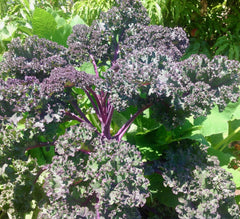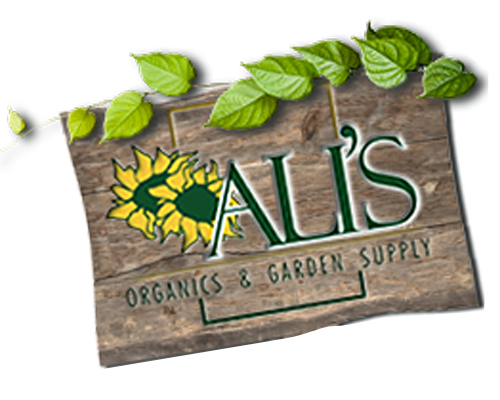Start a Successful Fall Garden
Posted September 06, 2012

Experienced gardeners know that the gardening season does not close at the end of summer. Instead, this is the time to plant fall vegetables and prepare for next season’s vegetable gardening activities.
PLANTING A FALL GARDEN
At the peak of the season, when fresh produce is abundant, it is difficult to think about planting more crops. Late July through September is the time to extend the vegetable growing season by planting a fall garden.
This planting will add more vegetables to your supply and make use of the full growing season. The fall garden requires less time and labor because the soil was already worked up in the spring. Just add some compost and a little fertilizer till or spade in and your ready to go. Many vegetables, such as broccoli and cauliflower, are of higher quality when grown in the fall rather than during late spring to midsummer.
Some vegetables, such as kale and Swiss chard, develop a better flavor after frost.
To prepare for a fall garden, remove all previous crop residues before seeding fall vegetables.
As in spring planting, prepare the ground by adding 2-3 inches of compost and spading, or tilling the soil to a depth of 6 to 8 inches and incorporating 3 to 5 pounds of an organic all-purpose garden fertilizer per 100 square feet. Plant the seeds according to directions on the seed packets. A good rule to follow is to plant seed two to four times its largest diameter.
Keep the soil evenly moist until the seedlings are up and growing; the upper 1/4 to 1/2 inch of soil must be moist at all times to ensure germination. This is particularly important because you will be seeding in midsummer, when the soil dries quickly. If you set out plants you have grown yourself or purchased from a garden center, plant them at the same depth that they were growing in the container. Firm the soil around each plant and water thoroughly. A Kelp tea is great to water transplants with.
FROST PROTECTION
As fall approaches, frost presents a threat to tender vegetables in the garden. Although many cool-season vegetables such as root crops will survive a frost, other crops will not. It is usually best to harvest pumpkins, and winter squash before a frost. If harvested after a frost or freeze, they will not store well. One way to protect plants from frost is to cover them with plastic sheeting, tarps, old blankets, boxes, or any other kind of close fitting cover. A cover is effective because it traps the radiated heat from the soil at night and raises the temperature enough around the plants to ward off a light frost. Cucumbers, beans, tomatoes, and squash are usually still productive in autumn and are worth trying to save for a few extra harvests. If a hard freeze is predicted, pick any green but mature tomatoes remaining on the vines or pull the entire plant. Store the tomatoes in a cool, dry place at about 65o F. They will continue to ripen for about two weeks. Squash, peppers, and eggplant should be picked and stored.
Some crops are not affected by frost or moderate freezes and can be left in the garden until the weather becomes quite cold. This group includes cabbage, broccoli, cauliflower, kohlrabi, Swiss chard, Chinese cabbage, and kale. Root crops, including beets, carrots, parsnips, and turnips, can be mulched with straw or leaves, left in the garden, and dug up as needed until
midwinter.
PREPARING THE GARDEN FOR NEXT YEAR
Fall is the best time to prepare the garden for the next season. While the weather is still good, a number of chores can be done to help get the garden ready for early spring planting. The main preparations are cleaning up garden refuse, sowing cover crops, if needed, and plowing the soil. Many organisms overwinter in garden debris. Collecting the leaves, stems, and old fruit reduces the potential for disease and insect problems in the following year. The cleanup should be done following the first killing frost. It is safe to put the debris in a compost pile as long as the material does not include diseased plants. If you are uncertain that all diseased plants have been eliminated, it is best to consider an alternative such as having it hauled away. Some disease-causing organisms that survive composting include: corn smut; clubroot of cabbage, broccoli, cauliflower, and other cole crops; Curly leaf of Tomatoes; Verticillium wilt of tomato, pepper, eggplant, and potato; and root-knot nematodes that infest quite a number of crops. Some of these organisms can overwinter in the soil indefinitely, even up to 15 years or more. Since rotation and sanitation have little effect on these diseases, the best control is to maintain adequate fertility levels in the soil. As many as 85 percent of disease-causing organisms are soil invaders. Plowing or tilling the crop residues into the soil in the fall helps prevent the overwintering of many of these organisms. In addition to destroying their winter homes, this practice also helps control the insects that transmit certain diseases. Crop residues that are turned under improve soil tilth and structure and help make spring garden work easier.
While the past season’s garden is still fresh in your mind, make a map or garden plan. This will be helpful in planning next year’s garden and deciding upon a crop rotation program. Crop rotation is an important measure that is used to control certain diseases. Since many disease organisms only attack related plants in the same family, you can sometimes avoid disease problems by not planting the same kind of vegetable in the same location in the following year. Wherever possible, avoid planting any vegetables within each of the following groups in the same location more than once every three years.
Fall is a also a good time to add organic matter to the soil to improve its tilth and fertility.
The most common sources of organic matter for garden soils are compost, manure, peat moss, rotted hay, straw, or a green manure crop.
CLEANING GARDEN TOOLS
The final gardening chore before winter’s arrival is the cleaning and winterizing of all garden equipment. Proper care will extend the life of your equipment, and gardening will be easier next spring with clean, sharp tools and easy-to-start engines. Clean your hand tools so that they are free of dirt and rust. A putty knife and wire brush are good tools for this operation.
After the dirt and rust are removed, sharpen the tools and, if necessary, coat all exposed metal surfaces with oil for protection against moisture. Store your tools in a dry, sheltered place. Wash and dry sprayers thoroughly. Be sure to drain all pipes, hoses, and valves. When these chores are finished, it is time to sit back, relax, browse through garden books and be ready to plant your vegetable garden when spring arrives next year.
Getting the Most from Your Fall Garden
High-density planting in double or triple rows can increase your per-square-foot return by 40 percent with broccoli, or up to 70 percent with cabbage. Use a zigzag planting pattern to fit more plants into less space while allowing 15-18 inches between plants.
Many varieties of broccoli are enthusiastic cut-and-come-again vegetables, too. After the main head has been harvested (taking only 3 inches or so of stem), varieties such as ‘Di Ciccio,’ and many others produce numerous tender side shoots. The harvest will continue until temperatures drop into the teens, which seriously damages broccoli plants. Covering your plants with a row cover will protect them. In much of Zone 7 and 8, healthy broccoli plants will keep spewing out shoots for months.
Planting Schedule:
12 to 14 weeks before your first killing frost
* Direct-sow last plantings of fast-maturing, warm-season vegetables such as snap beans, cucumbers and summer squash (make sure you look at the date to maturity and make sure that it is no longer then 70 days and don’t delay). Also sow parsnips and rutabagas.
* Start cabbage family seedlings indoors, and set out the seedlings as promptly as possible.
* In climates with long autumns (Hurricane Valley and St. George areas), plant celery, bulb fennel and parsley in the fall.
10 to 12 weeks before your first killing frost
* Set out broccoli, Brussels sprouts, cabbage, cauliflower, kale, kohlrabi and cauliflower seedlings, along with celery, bulb fennel and parsley.
* Direct-sow beets, cilantro, carrots, collards, leeks and scallions, along with lettuce and radishes. In some areas, even fast-maturing peas will do well in the fall garden.
8 to 10 weeks before your first killing frost
* Direct-sow arugula, Chinese cabbage, turnips, spinach, mustard, pac choi, tatsoi and other Asian greens.
* Sow more lettuce and radishes, including daikons.
6 to 8 weeks before first killing frost
* Make a final sowing of lettuce beneath a protective tunnel or frame.
On or around your first killing frost date
* Every fall garden should include garlic and shallots. I always plant on the first full moon in October.
October: Start to get your cold frame growing. Lettuces, spinach, and any greens do very well in cold frames. Prep your soil as you would for your garden adding compost and fertilizer.
November: This is the best time (for mild winter climates) to plant bulb onions and leeks. Plant from onion and leek plants rather then bulbs, the size of your onions will be far bigger this way. In very cold climates should wait until spring to plant leeks, onions and shallots.




Comments (0 Comments)
There are no comments.
Post Comment